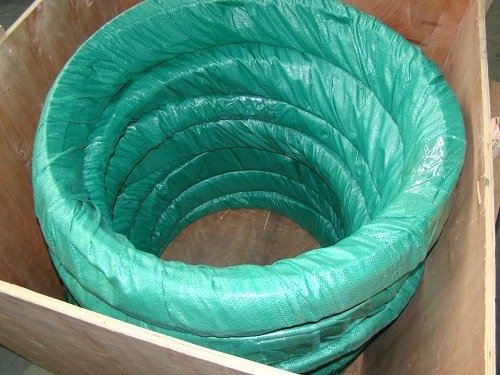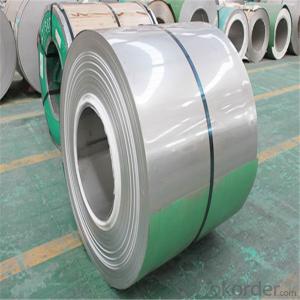Stainless Steel Coil with Good Price China
- Loading Port:
- Shanghai
- Payment Terms:
- TT OR LC
- Min Order Qty:
- 5 m.t.
- Supply Capability:
- 20000 m.t./month
OKorder Service Pledge
OKorder Financial Service
You Might Also Like
Item specifice
Product Description:
| Product name | stainless steel coil |
| Grade | (200 series& 300 series& 400 series..etc) 1.4301, 1.4306, 1.4845, 1.4401, 1.4371, 1.4597,1.4541, etc |
Standard | GB, JIS, ASTM, AISI |
Surface | pickled,bright or black |
Wall Thickness | range from0.3-38.1mm |
Outer Diameter | 0.5mm-530mm |
Length | AS PER CUSTOMER |
| Usage | Widely used in the areas such as fluid and gas transport,decoration,construction,medical equipment,aviation,boiler heat-exchanger and other fields. |
| Condition of delivery | Austenite in solution,ferrite in anneal or in accordance with client's detailed requirement |
| MOQ | 1 Metric ton |
| Price terms | CIF or FOB Shanghai |
| Payment terms | L/C or T/T |
| supply ability | 25 Metric tons per day |
| Delivery Detail | 7-30 days,according to the quantity. |
| Packaging Detail | Standard seaworthy package(1.plywood case2.wooden pallet package 3.bundle package and other package or as customer request)
|
Packaging & Shipping
Packaging


shipping

Our Services
Trade details (kindly need your attention)
1) Above all, in your inquiry, besides the diameter, please indicate clearly: the material of your required wire;
your requirement of surface and soft wire or hard wire . Because those are aslo key to calculating our cost and telling you prices for your ordered wire
2) Packing: standard export packing.
3) Payment:by L/C sight or T.T against copy of B/L
4) Shipment:10~15 days after receipt of the down payment or Irrevocable L/C sight.
5) Trade terms:FOB SHANGHAI,or CIF discharging port.
Our Advantages
(1): High quality stainless steel tube with reasonable price.
(2): Wide excellent experiences with after-sale service.
(3): Every process will be checked by responsible QC which insures every product's quality.
(4): Professional packing teams which keep every packing safely.
(5): Trial order can be done in one week.
(6): Samples can be provided as your requirements. Free sample
- Q:Can stainless steel strips be hardened?
- Stainless steel strips have the ability to be hardened. This type of steel alloy, known as stainless steel, contains chromium to improve its resistance to corrosion and staining. Beyond its well-known corrosion resistance and strength, stainless steel can also undergo a process called heat treatment to increase its hardness. Heat treatment consists of heating the stainless steel to a specific temperature and rapidly cooling it to modify its microstructure and enhance its hardness. Quenching, which entails immersing the steel in a liquid or gas medium like oil or water, is typically utilized to accomplish this rapid cooling. By carefully controlling the heat treatment process, stainless steel strips can be hardened to different levels of hardness, enabling them to meet the requirements of various applications that demand enhanced strength and durability.
- Q:How do you remove scratches from stainless steel strips?
- There are several methods you can try to remove scratches from stainless steel strips: 1. Begin by cleaning the surface using warm soapy water and a soft cloth. This will help eliminate any dirt or grime that may be concealing the scratches. 2. Try using a non-abrasive stainless steel cleaner or a mixture of water and baking soda. Apply the cleaner onto a soft cloth and gently rub it onto the scratched area in a circular motion. Make sure to follow the grain of the stainless steel to prevent further damage. 3. If the scratches are deeper, consider using a stainless steel scratch remover or a metal polishing compound. Apply a small amount of the product onto a clean cloth and rub it into the scratch using circular motions. Keep rubbing until the scratch diminishes or disappears. Remember to wipe off any excess product and rinse the area with water. 4. Another option is to use fine-grit sandpaper or a stainless steel polishing pad. Start with a lower grit sandpaper (around 400) and gently rub it over the scratch following the direction of the grain. Gradually switch to higher grit sandpaper (800, 1000) for a smoother finish. Afterward, make sure to clean the surface to remove any residue. 5. In case the scratches are too deep or extensive, it may be necessary to seek professional assistance to repair or replace the stainless steel strips. Always remember to test any cleaning or polishing method on a small, inconspicuous area first to avoid causing any damage.
- Q:How do stainless steel strips handle exposure to caustic solutions?
- Stainless steel strips possess remarkable corrosion resistance, which makes them highly appropriate for applications involving contact with caustic solutions. This attribute is attributed to the abundance of chromium in stainless steel, which results in the formation of a protective layer called a passive film on its surface. This passive film acts as a barrier, preventing direct contact between the steel and the caustic solutions, thus reducing the possibility of corrosion. Caustic solutions, such as strong alkaline substances or highly acidic solutions, have the potential to cause corrosion or damage to many other metals. However, stainless steel's resistance to corrosion allows it to withstand exposure to caustic solutions fairly well. The passive film on the surface of stainless steel is stable and has the ability to self-heal. This means that if it becomes damaged or scratched, it has the capability to regenerate and continue providing effective protection against corrosion. It is crucial to note that the resistance of stainless steel strips to caustic solutions may vary depending on the specific grade or alloy used. Different grades of stainless steel offer different levels of corrosion resistance, and some may be more suitable for certain caustic solutions than others. Therefore, it is of utmost importance to select the appropriate grade of stainless steel based on the specific application and the type of caustic solution it will be exposed to. To summarize, stainless steel strips generally exhibit good resistance to caustic solutions due to their inherent corrosion resistance. However, it is essential to choose the correct grade of stainless steel to ensure optimal performance and durability in corrosive environments.
- Q:Can stainless steel strips be used for solar panel frames?
- Yes, stainless steel strips can be used for solar panel frames. Stainless steel is known for its strength, durability, and resistance to corrosion, making it a suitable material choice for solar panel frames that need to withstand outdoor conditions. Additionally, stainless steel's high melting point and ability to handle thermal expansion make it well-suited for solar panel frames that are exposed to high temperatures.
- Q:What is the tensile strength after annealing of stainless steel strips?
- Various factors, including the specific grade of stainless steel, the parameters of the annealing process, and the intended application of the strips, influence the tensile strength of stainless steel strips after annealing. Annealing is a heat treatment process that involves subjecting the stainless steel strips to a specific temperature and gradually cooling them in order to modify their microstructure and enhance their mechanical properties. For stainless steel, annealing serves to alleviate internal stresses, increase ductility, and improve resistance to corrosion. In general, stainless steel strips tend to exhibit improved tensile strength after annealing compared to their initial state. However, the actual tensile strength achieved after annealing will vary depending on the factors mentioned above, especially the grade of stainless steel. Different grades of stainless steel possess distinct chemical compositions and mechanical properties, which affect their response to annealing. It should be noted that the annealing process must be carefully controlled to prevent excessive softening or grain growth, as these can result in a reduction in tensile strength. The specific annealing parameters, such as temperature, duration, and cooling rate, must be optimized to achieve the desired combination of tensile strength, ductility, and other mechanical properties. Ultimately, determining the tensile strength of stainless steel strips after annealing requires considering the specific grade of stainless steel, the parameters of the annealing process, and conducting suitable mechanical tests. Seeking advice from metallurgical experts or referring to technical specifications provided by stainless steel manufacturers can provide more precise information regarding the expected tensile strength after annealing for a particular grade of stainless steel.
- Q:Can stainless steel strips be used in marine environments?
- Yes, stainless steel strips can be used in marine environments. Stainless steel is highly resistant to corrosion, making it an ideal material for applications in marine environments where there is constant exposure to saltwater, moisture, and other harsh conditions. The chromium content in stainless steel forms a protective layer on the surface, known as a passive film, which helps to prevent corrosion and rusting. Additionally, stainless steel has excellent strength and durability, making it suitable for marine applications such as boat fittings, marine hardware, and structural components. It is important to select the appropriate grade of stainless steel for marine applications, with 316 and 316L being the most common grades used due to their higher resistance to corrosion. Regular maintenance and cleaning are also recommended to ensure the longevity and performance of stainless steel strips in marine environments.
- Q:Are stainless steel strips suitable for medical equipment?
- Yes, stainless steel strips are indeed suitable for medical equipment. Stainless steel is a popular material used in the manufacturing of medical equipment due to its exceptional properties. First and foremost, stainless steel is highly resistant to corrosion, making it ideal for medical devices that are exposed to bodily fluids and sterilization processes. It also has excellent strength and durability, allowing the equipment to withstand the rigors of daily use. Additionally, stainless steel is non-reactive, meaning it does not leach any harmful chemicals or substances into the patient's body. This makes it a safe and hygienic choice for medical applications. Furthermore, stainless steel is easy to clean and maintain, ensuring a high level of cleanliness and preventing the growth of bacteria. Overall, stainless steel strips offer the necessary qualities required for medical equipment, making them a suitable choice in the healthcare industry.
- Q:What is the creep strength of stainless steel strips?
- The creep strength of stainless steel strips refers to the material's ability to withstand long-term deformation under elevated temperatures and constant load. Stainless steel is known for its excellent creep resistance due to its high alloy content and specific microstructure. The creep strength of stainless steel strips depends on various factors such as the alloy composition, heat treatment, and grain size. In general, stainless steel strips have a high creep strength compared to other materials, especially at elevated temperatures. The presence of elements like chromium, nickel, and molybdenum enhances the creep resistance of stainless steel, allowing it to maintain its shape and structural integrity for extended periods under constant load. Additionally, the heat treatment process plays a crucial role in optimizing the creep strength of stainless steel strips. Proper heat treatment techniques like annealing or solution treatment followed by aging can help to enhance the material's microstructure and reduce the formation of harmful phases, such as sigma phase, that can decrease creep resistance. The grain size of stainless steel also affects its creep strength. Fine-grained stainless steel strips tend to exhibit better creep resistance compared to coarse-grained ones. This is because fine grains hinder the movement of dislocations, which are responsible for creep deformation. Overall, the creep strength of stainless steel strips is relatively high, making them suitable for applications that require resistance to long-term deformation and high temperatures, such as in power generation, aerospace, and chemical processing industries.
- Q:Are stainless steel strips suitable for HVAC applications?
- Yes, stainless steel strips are suitable for HVAC (heating, ventilation, and air conditioning) applications. Stainless steel is a highly versatile and durable material that offers excellent resistance to corrosion, heat, and pressure. These characteristics make it ideal for use in HVAC systems, which often operate in demanding environments. Stainless steel strips are commonly used in HVAC applications for various purposes. They are frequently used for manufacturing air ducts, which are essential components in HVAC systems for distributing heated or cooled air throughout a building. Stainless steel strips provide the necessary strength, rigidity, and resistance to withstand the pressure and temperature fluctuations that occur in ductwork. Additionally, stainless steel strips are also used in HVAC systems for producing heat exchangers, which are crucial for transferring thermal energy between fluids. The corrosion resistance of stainless steel ensures that the heat exchangers can withstand the exposure to different liquids and gases without deteriorating over time. Furthermore, stainless steel strips are preferred in HVAC applications due to their hygienic properties. They are easy to clean, maintain, and do not support the growth of bacteria or mold, making them ideal for use in environments where air quality is critical, such as hospitals and laboratories. In conclusion, stainless steel strips are well-suited for HVAC applications. Their excellent corrosion resistance, durability, and hygienic properties make them a reliable choice for manufacturing air ducts, heat exchangers, and other components used in HVAC systems.
- Q:Can stainless steel strips be used in elevator doors?
- Indeed, elevator doors can utilize stainless steel strips. Owing to its robustness, durability, and ability to resist corrosion, stainless steel stands as a favored option for elevator doors. These strips can enhance the visual allure of the doors, imparting a chic and contemporary look. Moreover, stainless steel is effortlessly cleaned and maintained, rendering it a pragmatic choice for elevator doors that experience regular usage and possible impact. Ultimately, stainless steel strips are an appropriate and frequently employed material for elevator doors.
1. Manufacturer Overview |
|
|---|---|
| Location | |
| Year Established | |
| Annual Output Value | |
| Main Markets | |
| Company Certifications | |
2. Manufacturer Certificates |
|
|---|---|
| a) Certification Name | |
| Range | |
| Reference | |
| Validity Period | |
3. Manufacturer Capability |
|
|---|---|
| a)Trade Capacity | |
| Nearest Port | |
| Export Percentage | |
| No.of Employees in Trade Department | |
| Language Spoken: | |
| b)Factory Information | |
| Factory Size: | |
| No. of Production Lines | |
| Contract Manufacturing | |
| Product Price Range | |
Send your message to us
Stainless Steel Coil with Good Price China
- Loading Port:
- Shanghai
- Payment Terms:
- TT OR LC
- Min Order Qty:
- 5 m.t.
- Supply Capability:
- 20000 m.t./month
OKorder Service Pledge
OKorder Financial Service
Similar products
New products
Hot products
Hot Searches
Related keywords



























